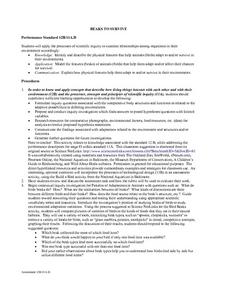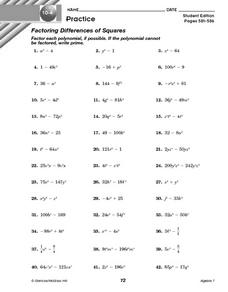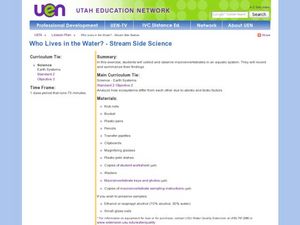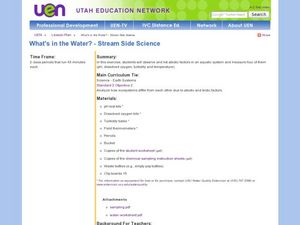Curated OER
Method of Solution
High schoolers explore the Method of Solution. They identify the components of the Method of Solution. Students develop the method of solution for a project that includes how the computer will be used, the mathematical equations needed...
Curated OER
Points in the Complex Plane -- Lab
Students review the lecture portion of this lesson. Individually, they graph various points on a complex plane and identify conjugates based on their location on the graphs. They complete a worksheet and review their answers to end the...
Curated OER
Marcy's Dots
Students identify the pattern changes that could occur in a series using pictures with dots. They use the patterns on the worksheets to have a context to describe pattern in words. Students look to find the linear, quadratic, or...
Curated OER
Beaks To Survive
Students discuss and identify the types of adaptations that are made by different organisms in order for them to survive. In groups, they describe the features of beaks and discuss how it affects their chances for survival. They share...
Curated OER
Getting To Know the Activists Among Us
Students discuss what it means to be an "activist." They identify various types of activist organizations and brainstorm the names of local people and organizations that might fit these categories. They research one of these...
Curated OER
Making Craters
Students study craters and identify the different things that characterize craters. In this crater lesson students create a model of an impact crater.
Curated OER
The Reciprocal Function Family
In this Algebra II worksheet, 11th graders examine the reciprocal function family in the form y = a/(x – h) + k, identifying the vertical and horizontal asymptotes. The two page worksheet contains explanation, examples, and two practice...
Curated OER
Nebraska's Geology, Soils, Groundwater Regions, and Topographic Regions
Students examine the distribution of geology, soils, groundwater, topography, and geography in Nebraska. They identify various regions and characteristics on a map, and develop a plan to manage the soil and groundwater resources of the...
Curated OER
Ice Creams
Students list all the outcomes for single events, and for two successive events in a systematic way. When dealing with a combination of two experiments, they identify all the outcomes, using diagrammatic, tabular or other forms of...
Curated OER
Changes Close To Home
Students interview the senior citizens in their community. While interviewing them, they identify perceptions they have about the local climate. Using the internet, the compare the results of the interview to those of public thirty...
Curated OER
Sound
Second graders study how sound is produced by vibrations and is transmitted through matter in all directions. They observe how sounds are produced and identify the ways in which sound travels.
Curated OER
Minimize Perimeter
Students practice calculating the perimeter of different sized rectangles. Individually, they identify the derivations of a function that can show the perimeter and determine how to minimize the perimeter within a fixed area. They use...
Curated OER
Chaos and Fractal Applications
Eighth graders identify the different applications of fractals. In this math lesson, 8th graders use graphing calculator to solve algorithms. They explain how changing parameters and initial conditions affect the solutions.
Curated OER
The Bridge Challenge
Students identify important structural elements in bridges. They use a worksheet and websites to investigate different types of bridges and variable factors that relate to building a bridge.
Curated OER
10-4 Practice: Factoring Differences of Squares
In this practice worksheet, learners factor the differences of squares and identify prime expressions. Polynomials contain one or more variables, with exponents. Students complete 42 problems. An answer key is provided.
Curated OER
Never Push Your Pendulum
Students investigate the behavior of pendulums and identify the variables that affect it. In this pendulum lesson students complete a lab on pendulums, make conclusions about frequency and the period then conduct a controlled experiment.
Curated OER
Who Lives in the Water? Stream Side Science
Andree Walker thought of everything when he wrote this resource. It includes a detailed list of materials and background information links for the teacher. In addition, it has procedures, a macroinvertebrate identification key, and tally...
Curated OER
Riding on a Pendulum
A comprehensive resource gets fourth grade physical scientists making observations about the period of a pendulum and then applying knowledge to a playground swing. Through seven different stations, they will record observations and...
American Chemical Society
Evaporation
This is one in several lessons that explore the relationship between temperature and phase changes of water. After some discussion, elementary physical scientists place wet paper toweling on a hot and a room-temperature water bag and...
American Chemical Society
Temperature Changes in Dissolving
Alia-Seltzer tablets cause a very obvious chemical change, but do they also cause a temperature change? Each class member explores hot/cold packs, discussing how these temperature changes occur. Groups then design and carry out their own...
Curated OER
That's Predictable - Stream Side Science
Research the impact that changes in biotic or abiotic factors might have on an ecosystem. Debate for or against the changes and take action in the community. This resource ideally follows stream studies that young ecologists may have...
Curated OER
What's in the Water? - Stream Side Science
Here is a complete activity in which young biologists or ecologists test the pH, dissolved oxygen, turbidity and temperature of stream water. The class visits an actual stream and makes observations of the site. They use scientific...
Curated OER
Wetland vs. Stream Macroinvertebrates
A link to a comprehensive macroinvertebrate guide gives you the information needed to prepare for this field study activity. Sample macroinvertebrates are collected from areas representing different environmental conditions. Junior...
Curated OER
Sound Busters
Fourth graders engage in a study of sound pollution at their school. After a class discussion on what noise pollution is, learners are asked if they think there are areas of their school or community where noise pollution is a problem....

























